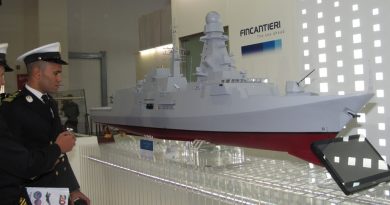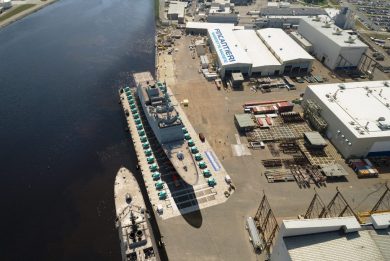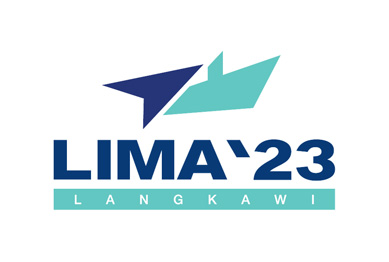
LIMA 2023 – Fincantieri unveils it FCX family of ships and proposes the FCX 15 for the Malaysian LMS programme
While ITS Morosini, the newest Italian Navy ship, was moored in Langkawi attracting considerable interest due to some exclusive high-tech solutions adopted, Fincantieri, the main Italian shipyard, unveiled at LIMA 2023 its FCX family concept, the FCX 15 being proposed for the Royal Malaysian Navy Littoral Mission Ship programme
Leveraging the work done on patrol ship and corvettes for Qatar, corvettes for the United Arab Emirates, and of course that with the Italian Navy on many programmes, Fincantieri decided to create a common line of ships that will give a “family feeling” and allow to widen the shipyard portfolio, ranging from light patrol boats to light frigates, the FREMM remaining the reference when considering heavy frigates.
Under the FCX name we find therefore five different ships, FCX07, FCX15, FCX20, FCX30 and finally FCX40, which displacement go from the 700 tonnes of the smallest one to the 4,000 tonnes of the bigger one. The FCX07 is based on the work done on UAE Falaj2 and Qatari Musherib classes, the FCX15 on Italian Navy Sirio-class and Comandanti-class units as well as on UAE Abu Dhabi-class, and finally the FCX30 takes its origins from Qatar Al-Zubarah-class. EDR On-Line understood than an FCX03 and an FCX10 might soon appear. Metrics of the five aforementioned FCX can be found in the table.

Modularity is of course a must, and as an example propulsion is available for all ships in diesel configuration, diesel-electric being provided should one of the bigger ships be fitted for antisubmarine warfare missions. The same applies to all other subsystems, the shipyard being able, together with other companies such as Leonardo, Elettronica and MBDA, to provide an all-Italian turnkey solution which would ease integration issues in the design/construction phase as well as in after-sales support. The open architecture design allows however integrating other third parties subsystems at customers’ will.
All FCX feature a flight deck and can operate rigid-hull inflatable boats; due to its dimensions the FCX07 has no hangar, while all intermediate-size FCX feature a retractable hangar, only bigger ones having a fixed hangar for recovering choppers.
The mission range depends on the type of ship, but all can be fitted with air defence, antisubmarine and surface combat capabilities, only the FCX07 lacking the ASW one.
Each type of FCX can be fitted with different levels of on-board sensors and weapon systems, usualy basic, intermediate and full combat, depending on the missions the customer requires the ship to fulfill.
One element that can be fitted to all FCX is the “Naval Cockpit”, the solution adopted in the aforementioned ITS Morosini, the second of class of the Thaon di Revel-class. On this ship the system, which works as an aviation cockpit, allows two officers, known as pilot and co-pilot, to directly control navigation, safety, and self-defence weapons, reducing to a minimum personnel on the bridge. The same concept can be applied on FCX, of course scaled down to cope with the needs of the unit.
Coming to the Asian region market, Fincantieri considers the FCX15 as the best fit for Malaysian LMS requirements, which is part of the wider 15-to-5 programme that aims reducing the number of platforms in service with the Royal Malaysian Navy. The shipyard is awaiting the reactivation of the Littoral Combat Ship programme for which Batch 2 it will propose its FCX30, currently bidding in Greece for the corvette programme.
The company is pretty active in the region, which it considers a potential growing market, considering the reaction by many countries to China expansion. Although nobody will match Beijing in numbers, many navies are looking at higher quality products that can have a considerable deterrence effect. Having a flexible and ready portfolio that allows answering a wide capability spectrum, without the need to purposely design a new class of ships, is the aim of the FCX concept, this reducing costs and delivery times. Through Vard, Fincantieri controls a shipyard in Vietnam; albeit for the time being this is not active on military ships, however its technical level should allow it to quickly reverse to them.
Photo by P. Valpolini



